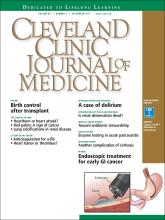A 71-year-old man with a history of hypertension, 4 prior myocardial infarctions (MIs), and well- compensated ischemic cardiomyopathy presented to the emergency department after 2 episodes of sharp pain in the left upper abdomen and chest. The episodes lasted 1 to 2 minutes and were not relieved by rest. Their location was similar to that of the pain he experienced with his MIs. He could not identify any exacerbating or ameliorating factors. The pain had resolved without specific therapy before he arrived.
He reported polydipsia and constipation over the past 2 weeks and generalized muscle weakness and acute exacerbations of chronic back pain in the past 2 days. Neither he nor a friend who accompanied him noticed any confusion. He had been taking as many as 15 calcium carbonate tablets a day for 6 weeks to self-treat dyspepsia refractory to once-daily ranitidine, and hydrochlorothiazide for his hypertension for 3 weeks.
FURTHER EVALUATION, CARDIOLOGY CONSULT
On physical examination, he had diffuse weakness, dry mucous membranes, and an irregular heart rhythm.
Electrocardiography (ECG) (Figure 1) showed ST- segment elevation in leads V1, V2, V3, II, III, and aVF and ST-segment depression in leads I and aVL. The corrected QT interval was 360 ms, compared with 426 ms 4 months earlier (Figure 2).
Electrocardiography at presentation showed a corrected QT interval of 360 msec. In addition to ST-segment elevations (blue arrows) and ST-segment depressions (blue diamonds), varying ectopic beats (red arrows) were present that were absent on previous studies.
An electrocardiogram 4 months earlier showed no ST-segment elevations (blue arrows) or ST-segment depressions (blue diamonds).
Laboratory testing showed the following:
Troponin I 0.11 ng/mL (reference range < 0.04); repeated, it was 0.12 ng/mL
Serum creatinine 3.4 mg/dL (0.44–1.27) (9 months earlier it had been 0.99 mg/dL)
Serum calcium 17.3 mg/dL (8.6–10.5)
Parathyroid hormone 9 pg/mL (12–88)
Serum bicarbonate 33 mmol/L (24–32); 2 weeks earlier, it had been 27 mmol/L.
A cardiology consult was ordered out of concern for ST-elevation MI (STEMI). The cardiology consult team did not recommend coronary angiography because the patient’s chest pain had resolved spontaneously, its presentation was atypical, and the results of laboratory studies indicated acute kidney injury, a relative contraindication to angiography.
DIAGNOSIS: MILK-ALKALI SYNDROME
The diagnosis, based on the presentation and the results of the workup, was milk-alkali syndrome complicated by recent hydrochlorothiazide use. This syndrome consists of the triad of hypercalcemia, metabolic alkalosis, and acute kidney injury, all due to excessive ingestion of calcium and alkali, usually calcium carbonate.
His hydrochlorothiazide and calcium carbonate were discontinued. He was given intravenous normal saline and subcutaneous calcitonin, and his serum calcium level came down to 11.5 mg/dL within the next 24 hours. His dyspepsia was treated with pantoprazole.
The patient had no further episodes of chest pain, and the cardiology consult team again recommended against coronary angiography. Repeat ECG after the hypercalcemia resolved showed results identical to those 4 months before his admission. Two months later, his serum calcium level was 9.4 mg/dL and his creatinine level was 1.24 mg/dL.
A MIMIC OF STEMI
In numerous reported cases, these electrocardiographic findings coupled with chest pain led to misdiagnosis of STEMI.1–3 While STEMI and occasionally hypercalcemia can cause ST elevation, hypercalcemia causes a significant shortening of the corrected QT interval that is not associated with STEMI.4,5
Ultimately, the diagnosis of MI involves clinical, laboratory, and ECG findings, and if a strong clinical suspicion for myocardial ischemia exists, STEMI cannot reliably be distinguished from hypercalcemia by ECG alone. It is nonetheless important to be aware of this complication of hypercalcemia to avoid unnecessary cardiac interventions.
- Copyright © 2017 The Cleveland Clinic Foundation. All Rights Reserved.








